Before “Angel”… before “Buffy The Vampire Slayer (both versions)”…there was “Tokyo Pop.” Long before Fran Rubel Kuzui played a major role in bringing those cult fantasy touchstones to life, she directed this pop romance set in economic bubble-era Tokyo. However, for years, interested viewers could not see “Tokyo Pop” in the theaters.
Thanks to the 4-Star Theater, that problem is corrected. On August 17 and 18, 2023, the theater will host showings of the 35th anniversary 4K Restoration of Kuzui’s first film “Tokyo Pop,” which folds Japanese rock and roll into a Western story. It begins in 1980s New York City. College dropout and wannabe rock and roll singer Wendy Reed (Carrie Hamilton) leaves her boyfriend’s band and America to try establishing her musical career in Japan. But her spontaneous trip to economic bubble-era Tokyo soon takes a turn towards regrettable desperation. That’s when Wendy’s path accidentally crosses that of wannabe Japanese rocker Hiro Yamaguchi (Diamond Yukai aka Yutaka Tadokoro). Hiro and his band have not managed to catch a career-defining break. Wendy and Hiro’s relationship goes from a bad first encounter to Wendy’s joining Hiro’s band (and becoming his lover) to unexpected fame. But is fame what either Wendy or Hiro need to fulfill their rock and roll dreams?
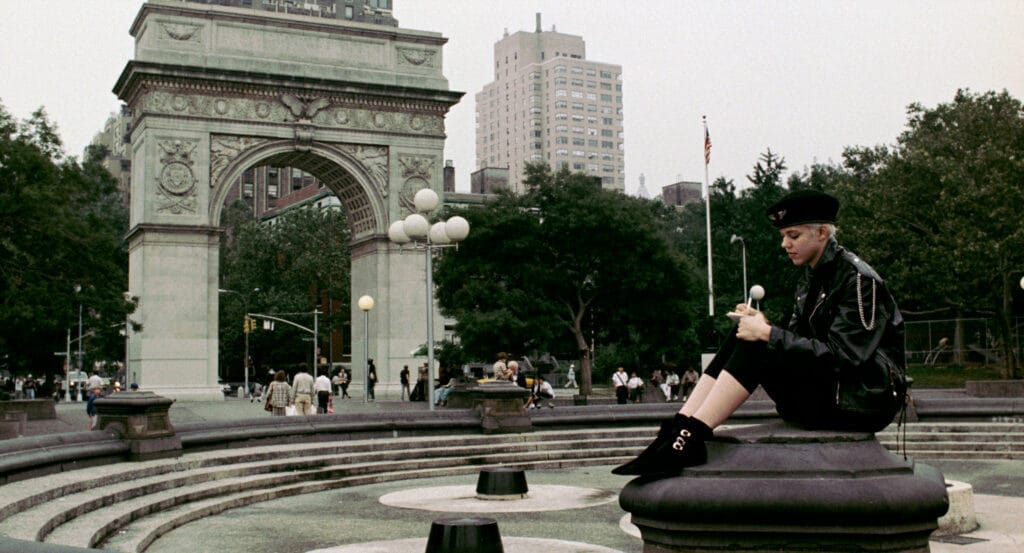
Carrie Hamilton in New York City in a scene from “Tokyo Pop”
Knowing how “Tokyo Pop” came about requires revisiting Kuzui’s ties to the 1980s American indie film scene. Fran and husband Kaz Kuzui turned their bringing of the first hip-hop movie “Wild Style” and classic Talking Heads concert film “Stop Making Sense” into a company distributing American films in Japan. She showed Jim Jarmusch the Kuzui Bandai robot toy collection and shared a cold one with Spike Lee in his messenger days. And she was encouraged by her indie film peers to realize her dream of being the first foreign female director to make a Tokyo-set film.
The History of “Tokyo Pop” And Its Restoration in 2019
“Tokyo Pop” became an official selection of the 1988 Cannes Film Festival, and was also screened in many European and Asian theaters. But then the film’s post-theatrical life became a lot less golden. The distributor of Kuzui’s film went bankrupt before the film could be preserved on video. All the existing 35 mm prints vanished, which made the idea of later film festival showings impossible. Kuzui herself soon forgot about her labor of love.
Fast forward to 2019. A hitherto unknown print of “Tokyo Pop” was discovered at the Academy Archives of the Academy of Motion Pictures Arts And Sciences, and publicly screened. After the well-received screening, Sandra Schulberg of IndieCollect announced the Jane Fonda Fund would help fund the restoration of Kuzui’s film. But this bit of great news didn’t end “Tokyo Pop”’s travails. The combination of COVID and its lockdowns, the near loss of the film’s negative, and the disappearance of the film’s sound materials might have ended the planned restoration there. Fortunately, thanks to several heroic efforts, the restorers managed to assemble all the physical pieces needed to create a sparkling new version of the film.. Added to the mix was the financial support of Dolly Parton and famed comedian Carol Burnett…whose daughter was the late Carrie Hamilton.
Now the 4K restoration of “Tokyo Pop” is complete, just in time to celebrate the film’s 35th anniversary. San Francisco viewers will have a chance to check out this long unseen 1980s indie cinema gem on August 17 & 18, 2023. That’s when the 4-Star Theater will show Kuzui’s first feature film, and viewers will get to see on the big screen such delights as late artist Keith Haring’s playful opening credits.
Broke-Ass Stuart’s was lucky enough to interview Kuzui before the restoration’s San Francisco debut. This resulting e-mail interview has been lightly edited for clarity.
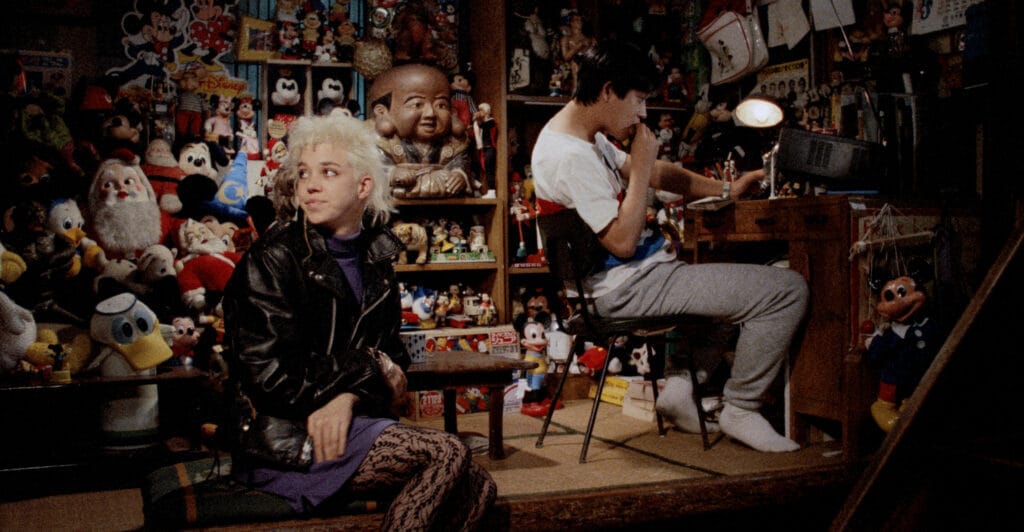
Wendy at the Mickey House
Which celebrity contributed the most to making “Tokyo Pop” and/or its restoration happen?
It’s incredibly impressive seeing the celebrities both in front of and behind the scenes who made Tokyo Pop” happen or helped bring the film back for a new generation. For example, Keith Haring created the film’s opening titles. Carol Burnett and Dolly Parton helped bankroll the 4K restoration that’s being shown in S.F. Which celebrity contributed the most to making “Tokyo Pop” and/or its restoration happen? And what did they do?
Fran Rubel Kuzui (FRK): “That’s not the easiest question to answer. From the very beginning everyone has poured so much inspiration and care into the making and then restoration of the film. Both Carrie Hamilton and her mom, Carol Burnett, have encouraged the creation of “Tokyo Pop” from [D]ay [O]ne. As I watched the film so many times during the restoration and with 30 years’ perspective on the film, I was struck by what amazing collaborators both Carrie and Diamond Yukai were. I see Carrie’s performance and remember so many things that she suggested for the film as both an actor and musician. The same for Yukai. As for Carol, when we finished the film and started to show it at film festivals, she was always supportive and always showed up if we needed her. When I told her we were restoring the film and IndieCollect needed financial support, she never hesitated.”
How would you characterize your film’s portrait of Wendy’s and Hiro’s interactions with each other and the larger Japanese society?
A casual plot summary makes “Tokyo Pop” sound as if it’s a culture clash comedy. Yet the misunderstandings and understandings Wendy and Hiro reach never end with American pop culture being found superior to Japanese culture or vice versa. How would you characterize your film’s portrait of Wendy’s and Hiro’s interactions with each other and the larger Japanese society?
Fran Rubel Kuzui (FRK): “That’s a tough question. You can choose to be kind and compassionate, or you can choose not to be. I don’t think we were looking to find anything superior. That doesn’t support good art. I tried to let everything be what it is. As for their interactions, I hope that I looked at the characters with love. A lot of the interactions came from my relationship with my husband and partner Kaz, who produced the film and was a great role model. So as I said, you can choose to be kind in your communication and I think that’s what we were trying to do.”
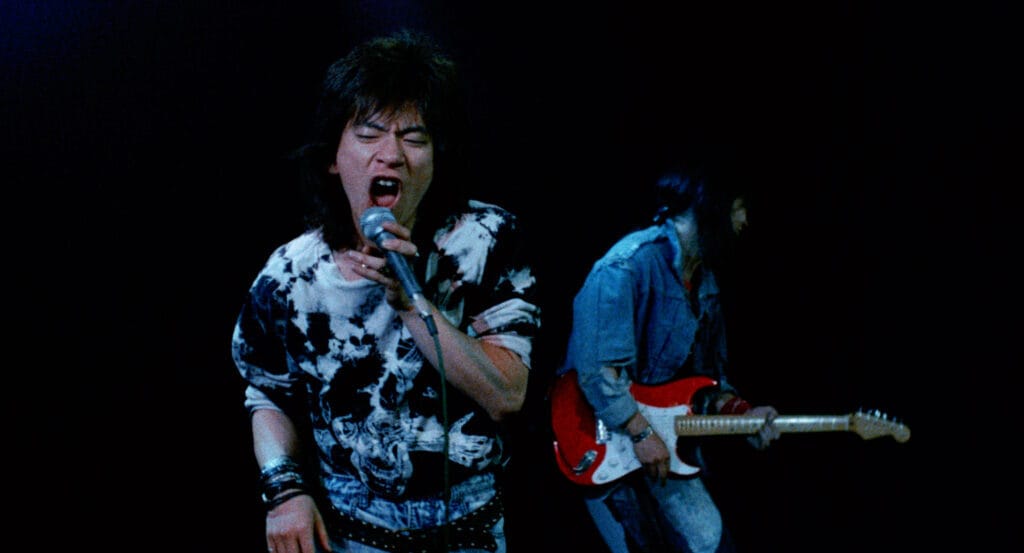
Hiro (Diamond Yukai) on stage
How much of her behavior in the film is your pushback against the more aggressive tone towards Japanese life taken by the male American film directors who preceded you?
Wendy’s attempts to adjust to life in Japan makes her more of a naif than a white savior. How much of her behavior in the film is your pushback against the more aggressive tone towards Japanese life taken by the male American film directors who preceded you?
FRK: “Ah, that’s what I was looking for. I set out to write the script with the premise that all films that had been made in Japan by Western people had been made by men. So I began to think about what, as a female director and writer, I could show about Japan that was different imagery and from a fresh perspective.”
What keeps her from falling into the Ugly American category?
Wendy never really increases her fluency in Japanese nor understands Japanese culture a little better. Aside from her romance with Hiro, what keeps her from falling into the Ugly American category?
FRK: “Wendy is not in Japan all that long and Japanese is not that easy to learn quickly. I like to think she was learning it…[S]he really does try to experience Japanese culture. She asks Hiro to show her more of his culture and they travel out of Tokyo. He also takes her to a big festival that his grandfather attends. She’s doing her best to earn money and support herself. I don’t know how much leisure time she would have had. Then she gets caught up in Dota-san’s world. It’s not that easy to be a foreigner in Japan. One does their best.”
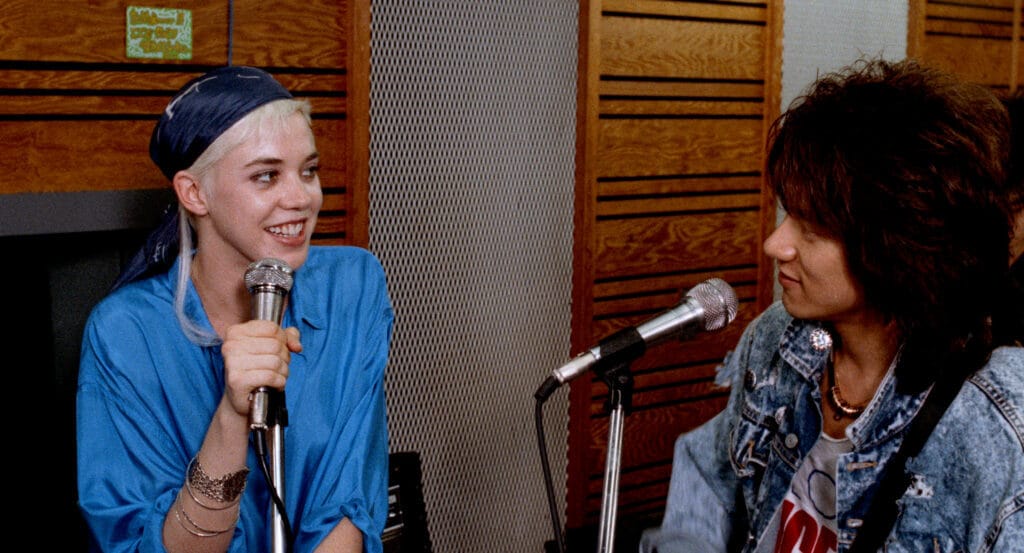
Wendy and Hiro performing in the studio
How many of these adoptions are signs of Japanese cultural integration and how many seem a form of Japanese cultural cosplay?
BAS: The Japanese seen in “Tokyo Pop” adopt Western accouterments to various degrees. The viewer sees such things as “Home On The Range” sung at Wendy’s karaoke bar, Hiro’s family having a Kentucky Fried Chicken breakfast, and the sight of kids skateboarding. How many of these adoptions are signs of Japanese cultural integration and how many seem a form of Japanese cultural cosplay?
FRK: “I didn’t see it as either. I see it as modernization. For example most of the jeans and bicycles in the US were made in Japan but we didn’t see them as Japanese. [O]nce I got into a discussion with Yukai’s band members about hamburgers. They were shocked to hear that I thought of them as American. “They’re just hamburgers!” they cried. Same as kids in the US going into McDonalds and ordering a croissant [without] think[ing] they’re eating French food.”
What were some things in the film that were drawn from real life?
To some degree, “Tokyo Pop”’ is autobiographical. What were some things in the film that were drawn from real life? My guesses are that Wendy’s grumbling about Tokyo’s lack of street signs and the open air market where Hiro and Wendy meet again are actual events or places.
FRK: “Yes, they’re very real. When I wrote the script I saw myself as the Hiro character because his struggle was to find his authentic self and I saw Wendy as my husband Kaz, who encourages her to do so. Thirty years later when I saw the film again, I had a good laugh at myself. Of course the character of Wendy is me and all the things I just didn’t and still don’t understand about Japan. But those things aren’t things I see as wrong! They’re unique and possibly very much what makes Japan and Japanese culture so unique and wonderful. Okay, full disclosure here. After I met Kaz making a film in NY he invited me to come visit him in Japan. And there I was, Wendy hitting Tokyo cold turkey with no advance knowledge of where I was. In my case I wound up staying at Kaz’s apartment with no other gaijin to consult along the way. After about a month some friends from New York came to Japan to film a TV commercial and they asked if I’d be available to work on it as a script supervisor, which was my job at the time.
I was really excited to get the opportunity to travel to Kyoto with them. And to stay at a hotel! I could finally be a visitor/tourist. The film crew went down to Kyoto and we all checked into a really swanky hotel. We agreed to drop our bags in our rooms and meet back in the lobby bar in 30 minutes. Up in the room I couldn’t believe how posh it was compared to Kaz’s Japanese style apartment. There was even hot running water and fluffy pillows. On the desk there was a pamphlet for tourists. So I started leafing through it. There were pictures of the money, etc. and I eagerly confirmed my primitive understandings of things. And then there were these funny illustrations of how to use a Japanese toilet, which was basically a “squatty” kind of sunken bowl in the ground over which you squatted. Western style toilets were just coming into fashion. I looked at the illustrations and my jaw dropped. I realized that I had been facing the wrong direction on “squatties” for over a month. It was really humbling. When I got home to Tokyo I told Kaz and I think he laughed for months. He told everyone we met how funny and cute I was.”
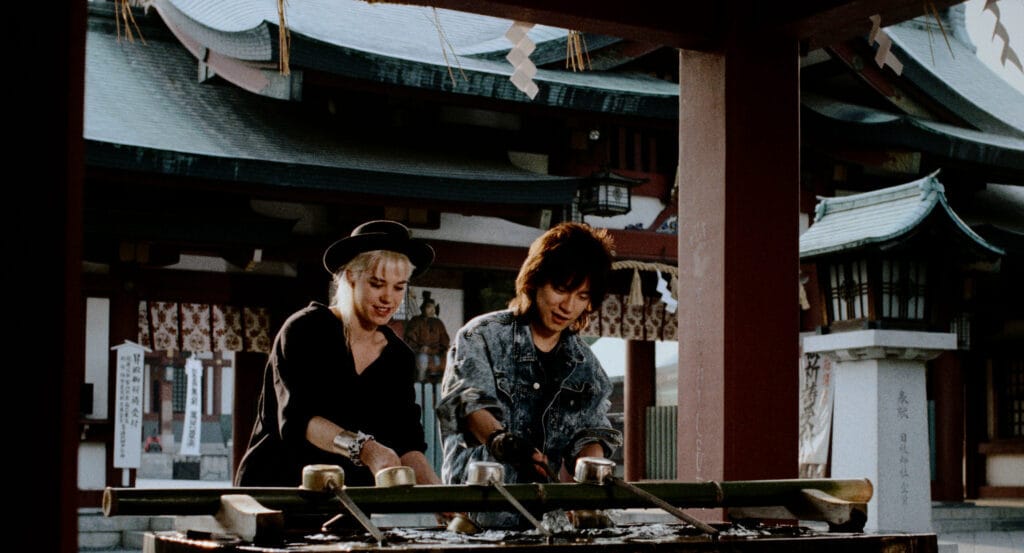
Wendy and Hiro at a Japanese temple
You’ve frequently written about Japan over the years. What are the sort of wrinkles the Japanese have added to imported Western pop culture that have most impressed you?
FRK: “I have such respect for how Japanese culture is able to appropriate any foreign culture and make it seem Japanese. I’ve especially loved watching the growth of hip hop music, fashion and attitude and how it’s become Japanese. And I love seeing how Japanese fashion has bled into Western fashion.”
How can the DIY spirit thrive in a culture that seems to de-emphasize individualism?
Based on what you said about Japanese cultural appropriation, it sounds as if punk music and its DIY ethos might be the exception to your statement. Daniel Sinker of “Punk Planet” notes that “Punk has never waited for anyone to step out on its own. DIY is the answer to ‘Why?’” How can the DIY spirit thrive in a culture that seems to de-emphasize individualism?
FRK: “Well, my understanding of punk music is that it’s a form of rebellion or a symbol of rebellion usually aligned to social or political upheaval. I’m not an expert on this in any way but I would suppose that an understanding of punk spirit in Japan is more an alignment with the general ethos of punk. Since there is little social upheaval or political friction, I would imagine Japanese fans are expressing personal frustrations by following punk music and musicians.”
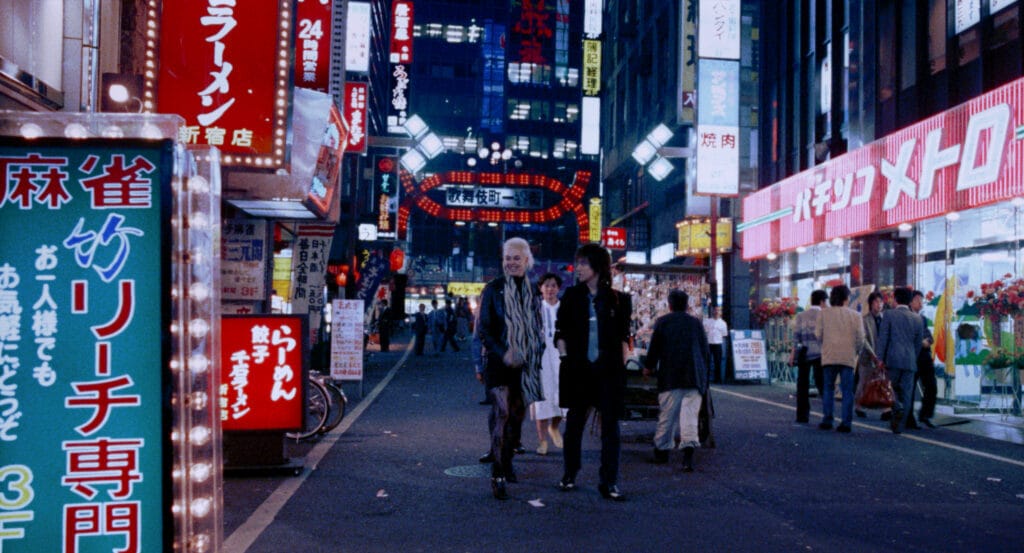
Wendy and Hiro on a night time walk through Tokyo
How much do you think American appreciation of Japanese culture has advanced beyond the phenomenon of “eat sushi and enjoy their cartoons? What should Western fans whose image of modern day Japan was formed primarily by exposure to anime take away from “Tokyo Pop?
When “Tokyo Pop” came out in 1988, American appreciation of anime and manga was on the cult audience level. Looking back, how much do you think American appreciation of Japanese culture has advanced beyond the phenomenon of “eat sushi and enjoy their cartoons?” (Pace, Eddie Murphy) What should Western fans whose image of modern day Japan was formed primarily by exposure to anime take away from “Tokyo Pop?”
FRK: “I’m not sure there was ever only that perspective. Japan has a very rich culture which has always been appreciated by the West. One of the greatest influences on Impressionist painting was Japanese woodblock prints. And Japanese chefs have greatly influenced Western cuisine. Japanese knives are the gold standard…There’s a lot more there folks! Dive in.”
(All stills from “Tokyo Pop” courtesy of Kino Lorber.)
(The 35th anniversary 4K restoration of “Tokyo Pop” screens at the 4-Star Theater at 7:30 PM on August 17, 2023 and 5:30 PM on August 18, 2023. The film plays on a double bill with “Tampopo.” For further information about the film and to order advance tickets, go here.)
The post “Tokyo Pop” Turns 35, and Director Fran Rubel Kuzui Talks About Her Film appeared first on Broke-Ass Stuart's Website.









